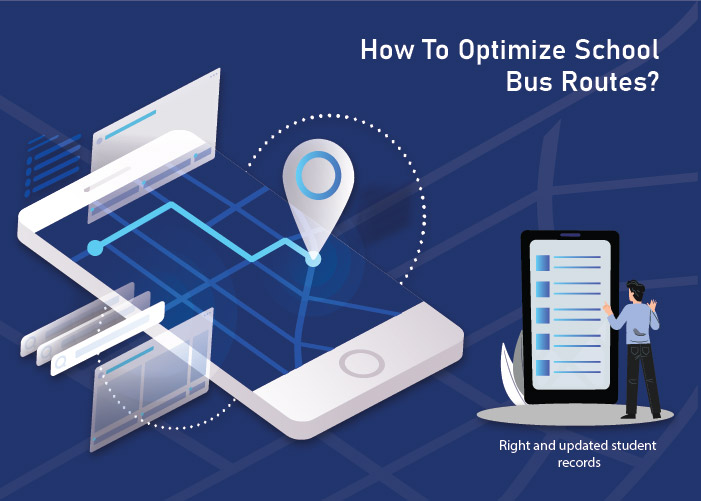Summary
By using modern, GPS-enabled software systems combined with hardware like a tracking device installed within buses as well as apps installed on phones of users (e.g. drivers), a “real-time” bus tracking system can monitor the movement of buses on a map. Data such as the speed of the bus, the distance covered, the remaining distance to its destination, the number of scheduled stops (etc.) is received by Fleet managers in real-time. This helps them in taking any corrective action should there be any deviation or delays.
An important part of bus-tracking is the school-bus segment since it is greatly beneficial for parents and school authorities to be able to monitor the safe transit of their children.
What is a real time bus tracking system?
As the name indicates, a “real-time bus tracking system” tracks the movement and locations of buses traveling along various routes at different times and provides live data in “real-time” to a central control room. This helps Fleet Managers in the central location to monitor the progress of the buses i.e. whether they are traveling on pre-assigned routes, maintaining projected times, adhering to safety protocol while driving, making the prescribed number of stops (etc.).
Unfortunately, deviation from the planned routes and timelines are often necessitated due to issues like sudden traffic jams and inclement weather – these often cause delays and need buses to be re-routed. When such deviations occur – e.g. when a bus either breaches the route prescribed, or its geofencing parameters or is taking longer than expected – the system alerts the Fleet Managers, who can take the required corrective actions in a prompt manner.
School bus tracking: Quite naturally, such a system is most helpful in tracking school buses since it helps parents, as well as school authorities, monitor the movements of their children. They can track whether the bus has left, or reached, the school premises when it will arrive if their child has boarded the bus, alighted per schedule (etc.). This helps both, parents and school staff, to organize their timings to manage the safe transit of the children on a daily basis.
How does real-time bus tracking work?
Such a system is integrated across its various users (stakeholders) right from the centralized control room (i.e. where the Fleet Managers or school authorities are located) to the bus itself (via an embedded/installed tracking device), as well as the driver (via an App on his phone). Additionally, the buses can also be installed with a scanner (a hardware device) that can scan (e.g. via QR codes, RFID tags) those that are boarding and alighting the bus e.g. employees, students, school staff and record the relevant details as required.
What are its benefits? This system of real-time tracking and the transparency – or, visibility- that it provides Fleet Managers helps them across several aspects of managing all the buses in their network.
- Fleet Managers can use automatic route-optimization techniques to minimize distances travelled by their fleets, thereby reducing fuel consumption, minimize operating costs, saving time, and managing maintenance schedules without having to obstruct daily schedules (which, in turn, reduces downtime and breakdown costs)
- Bus drivers can be alerted of developing problems such as traffic congestion, and approaching poor weather. Drivers can also be intimated (and, trained for improvement) for breaching speed limits, taking wrong routes, hard-cornering, sudden braking, and poor driving habits such as sudden acceleration or deceleration. Such best practices serve to maintain a strong safety record, save lives in society by minimizing accidents, and ultimately, to reduce company insurance premiums
- Most importantly, it provides parents of school-going children with the assurance of knowing exactly where their child is at all times (when in transit and outside the safe confines of school premises).
Bus-tracking Apps: how do they work?
A bus-tracking app forms part of the entire system of real-time bus management and serves as a convenient access point when downloaded onto the phone of the users (stekholders_ of the overall system. These include bus drivers, employees, school children, and their parents.
- To begin with, a bus-tracking app uses modern GPS technology (Global Positioning System). Such a system acts as a receiver, which receives radio signals emitted via satellites around the earth. The signals received (from four or more satellites) are used to figure out the recipient’s exact location on the planet via complex algorithms, Artificial Inteligence and Machine Learning tools
- GPS devices are installed within a bus and these devices transmit their location in real-time on a map. Details such as ETA (expected-time-of-arrival) can be calculated by using this data. When a user enters his destination details, he can see details like route options, how far the bus is, the speed at which it is travelling (etc.)
- Since commute and travel is always dependent on fickle real-world elements like changing weather conditions, traffic congestion, and other factors (e.g. road blockages) that could cause deviations or delays on prescribed routes, the system keeps the users informed about its progress and any deviations or delays via notifications/ SMS
Using bus-tracking Apps to track school-buses
As you would imagine, school buses that transport children on a daily basis form an important segment of bus travel – particularly because they are young children that need to be guided. Therefore, the benefits of using such apps to monitor school buses are truly beneficial and are a boon to children’s parents as well as school staff/ authorities to track bus movements in real-time.
- As mentioned above, the buses are installed with GPS devices that are connected with the school’s systems. School authorities track it from their control-room monitors while parents can track the movement on their mobile phones and other hand-held devices e.g. tablets
- The bus-tracking app provides parents and authorities a map view of the current position of the bus with information of where the bus is currently, the speed at which it is travelling, how long before it arrives at their stop (etc.)
- These systems also conveniently facilitate the driver in communicating directly with the school authorities and the kids’ parents if there are unplanned deviations or delays. The app also displays information about the causes of such delays
- Students use “RFID tags” while boarding-alighting from the buses to record themselves into the bus-tracking system – this data itself is used to track their daily attendance by sending it directly to teachers and parents. Not only are parents assured of their children’s whereabouts but it also reduces time spent by teachers in administrative tasks like marking out daily attendance.
Thus, through the use of modern-GPS technology, a live-bus tracking app has made the process of kids’ school pickups and drops off a much safer practice.
Conclusion: As seen above, a live bus-tracking system is a great tool to use. Be sure to select a reputed school bus tracker to help implement it and improve the efficiency of managing your bus operations.



